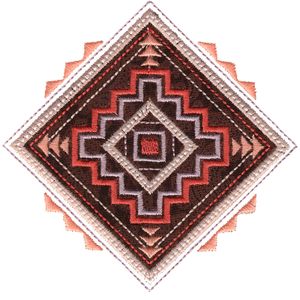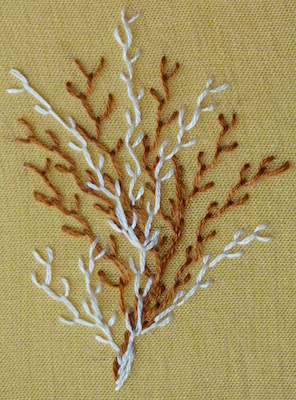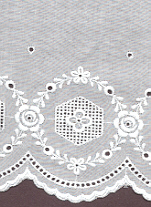Embroidery glossary
Jump to navigation
Jump to search
Terminologies used in embroidery
This glossary was created on the basis of Abcoln glossary and enriched with videos from YouTube and images from Pixabay and other sources (mentioned in the description of each photo). Having visual representation next to the term & the description, helps memorize terminology faster and retain it longer.
A-D
| Terminology | Description | Image/ Video |
|---|---|---|
| Aetzing | The process used to create schiffli laces. The base fabric is dissolved, leaving the threads that have been stitched together to form the lace. |
 |
| Anti-Pilling | A treatment applied to the garment to prevent pilling, or the formation of little balls of fabric due to wear. | Anti-Pilling treatment |
| Appliqué | 1) Decoration or trim cut from one piece of fabric and stitched to another to add dimension and texture. If appliqué occupies a significant amount of the design, the stitch count is lower. 2) In schiffli embroidery, an embroidered motif, hand cut or aetzed away from the base fabric. |
 |
| Backing | Woven or nonwoven material used underneath the item or fabric being embroidered to provide support and stability. Can be hooped with the item or placed between the machine and throat plate and the hooped garment. Available in various weights and in several versions - cutaway, tearaway and solvable. See Hooping and stabilizing in computerized embroidery |
 |
| Balboa Stitch | A technique used to produce tone-on-tone designs that feature the actual stitches as a background and give the fabric prominence. Has an embossed appearance. | Balboa Design Package |
| Blending | A digitizing technique that makes different colors of thread flow together in a more pleasing manner. Relies heavily on variable densities. Gives a design a more realistic, 3-D look | Blending |
| Buckram | Coarse, woven fabric stiffened with glue, used to stabilize fabric for stitching. Commonly used in caps to hold the front panel erect. |
 |
| Cartoon | Finished artwork of an embroidery design to be digitized. Usually six times larger than the finished design size, based on the art-to-stitching ratio historically used in the schiffli industry. | Vectorizing a drawing |
| Chenille | Form of embroidery in which a loop (moss) stitch is formed on the top side of the fabric. Uses heavy yarns of wool, cotton or acrylic. Created by a chain stitch machine that has been adjusted to form this stitch type. In North America chenille is most commonly recognized as the emblems and letters sewn on letterman’s jackets. Historically chenille has had many uses in fashion and furnishings, from delicate work of lace to the bold look of school mascots, chenille is a form of embroidery most of us recognize. |
 |
| Colors | Colors in embroidery art can be chosen at the begining of work or adjusted with embroidery mashine. | Colors in the Art-to-Stitch process |
| Cross-Stitch | Regular bean stitch movements forming x's in rows or within a box shape to form geometric designs. Creates a handmade appearance. |
 |
| Crystal Heat Transfers | Metallic studs or crystals strategically placed to form a design. While this can be done by hand, most of the time that method is too time-consuming to be cost effective. Ready-made transfers are available, and custom transfers can also be ordered from some companies. New to the embroidery industry are both stitch designs and apliqués that have accompanying transfers specifically calculated to fit and enhance the embroidery. | Hotfix |
| Debossing | Depressed imprint created by a machine pressing a dye into the surface of fabric or material. Popular in leather decoration. | Embossing & Debossing |
| Digitizing Tablet | A computer-aided design device used by digitizers to plot needle penetrations for embroidery designs. Typically, a pencil drawing of the design is enlarged and then taped to this tablet. The digitizer then uses a device known as a puck to indicate stitch types, shapes, underlay and actual needle penetrations. |
E-H
| Emblem | Logo or design with a finished edge. Commonly an insignia of identification, usually worn on outer clothing. Historically, an emblem carried a motto, verse or suggested a moral lesson. Also known as a crest or patch. |
 |
| Embossing | A surface effect achieved on fabric by means of passing cloth through a series of engraved rollers that impart figures or designs to its surface. Rollers work through heat and pressure. | Embossing & Debossing |
| Embroidery | Decorative stitching on fabric. Generally involves non-lettered designs but can also include lettering and/or monograms. Evidence of embroidery exists during the reign of Egyptian pharaohs, in the writings of Homer and from the Crusaders of the 12th century. Evolved from handwork to manual sewing machines and from handlooms and schiffli machines with hundreds of needles to high-speed, computerized multi-head machines. |
|
| Facing | Is just an extra bit of fabric that you sew to the edge of your garment, front opening, cuffs or arms of a garment to create a finished look. |
 |
| Fancy Fills | A digitizing function that automatically incorporates special patterns or textures into fill areas. Also known as specialty fills. | Fancy fill_Part 1 Fancy fill_Part 2 |
| Feather Stitching | Lightweight designs constructed of run stitches. Ideal for tricots, nylons and taffetas. |
 |
| Finishing | Processes performed after embroidery is complete. Includes trimming loose threads, cutting or tearing away excess backing, removing topping, cleaning any stains, pressing or steaming to remove wrinkles or hoop marks and packaging for sale or shipment. | |
| Flagging | Up-and-down motion of goods under action of the needle. It's called flagging because of it resembles a waving flag. Often caused by improper framing of goods, flagging may result in poor registration, unsatisfactory stitch format and birdnesting (accumulation of thread caught between the embroidered item and the needle plate). | |
| Foil | Comes in several colors, with the most popular being red, gold and silver. To use foil, screen print the garment as usual, place the foil over the wet ink, remove the garment from the platen, and cure it with a heat press. The printed and foiled garment can be flash dried before it's removed from the platen, and other colors then can be printed on top of the foil. |
 |
| Free-Standing Lace | Digitized so that the threads are interwoven. The embroidery of lace requires a soluble backing or topping of the embroiderer's choice for the substrate. The lace design is embroidered on the soluble product, which is then washed away, leaving just the thread in place. Many of the lace designs require additional work, shaping them into projects such as baskets, ornaments or doilies. |
 |
| Grommets | Small holes that allow for air circulation and ventilation, usually found underarm or in the back neck of garments. |
 |
| Hoop | Device made from wood, plastic or steel with which fabric is gripped tightly between an inner ring and an outer ring.
Machine hoops are attached to the machine's pantograph and are designed to push the fabric to the bottom of the inner ring and hold it against the machine bed for embroidering. |
 |
K-P
| Lace | The use of threads alone to produce a designed fabric. Most often used to embellish women's apparel and home fashions. |
 |
| Lettering | Embroidery using letters or words. Lettering, commonly called "keyboard lettering," may be created using an embroidery lettering program on a PC or from circuit boards that allow a variance of letter styles, sizes, heights, densities and other characteristics. | Stitch Era Lettering |
| Lock Stitch | Commonly referred to as a lock-down or tack-down stitch, a lock stitch is formed by three or four consecutive stitches of at least a 10-point movement. It should be used at the end of any element in your design where jump stitches will follow, such as color change or the end of a design. May be stitched in a triangle, star or in a straight line. Also the name of the type of stitch formed by the hook and needle of home sewing machines, as well as computerized embroidery machines. | Lock stitches |
| Looping | Loops on the surface of embroidery, generally caused by poor tension or tension problems. Typically occurs when polyester top thread has been improperly tensioned. | Example |
| Monogram | Embroidered design composed of one or more letters, usually the initials of a name. |

|
| Needle | Small, slender piece of steel with a hole for thread and a point for stitching fabric. A machine needle differs from a handwork needle; the machine needle's eye is found at its pointed end. Machine embroidery needles come with sharp points for piercing heavy, tightly woven fabrics; ball points, which glide between the fibers of knits; and a variety of specialty points, such as wedge points, which are used for leather. | needles for embroidery |
| Pad Printing | Pad printing utilizes a flexible silicone rubber transfer pad that picks up a film of ink from a photo-etched printing plate and transfers it to an item. Pad printing is usually used for 3-D items |
 |
| Patches | Made from twill fabric, patches have a merrowed edge and an adhesive back. Most embroidery shops don't own a merrowing machine, so making patches from scratch isn't an option, nor is it cost effective. One can still, however, supply them for the customer. Companies that specialize in making patches are plentiful, and the prices are much better than the average embroidery shop can manage. For the small odd jobs, though, blank patches are available in many shapes, colors and sizes. | Embroidery patch |
| Photo Stitch Designs | Created from a scanned photo; the photograph is imported into the digitizing software, and with a few keystrokes the design is digitized and ready to sew. The possibilities for uses are endless, ranging from portraits to buildings. A series of run stitches and loose fills are used to replicate a photograph with cloth and thread. Photo stitch designs are popular with individuals and corporations. | Digitizing a portrait photograph |
| Piqué | A fabric of cotton or spun rayon woven lengthwise with raised cords. | |
| Puff Embroidery | A technique popular in the early '90s, and seems to be gaining popularity again. A special thick backing is placed in the hoop under the substrate, usually a sweatshirt. The design itself consists of light fill and blank spaces. The technique works great for names, with light fill separating letters that are negative. In the embroidery process, the blank spaces puff up and the area between them is flattened by the fill stitches. | 3D Puff Embroidery |
| Pull Compensation | A degree of distortion built into a design by the digitizer to compensate for pull on the fabric caused by the embroidery stitches. | Dealing with push/pull distortion |
R-T
| Reverse Appliqué | A process in which the fabric is placed on the underside of the garment, and the garment is cut along the tack-down stitch so that the material shows through. Not nearly as easy as regular appliqué, the process, however, shouldn't be discounted. The dimension that the technique provides is quite different from regular appliqué, and when your customer wants a unique look, this might be something to consider. |
 |
| Run Stitch | Consists of one stitch between two points. Used for outlining and fine detail. Also known as a walk stitch. |
 |
| Satin Stitch | Formed by closely arranged zigzag stitches. Can be laid down at any angle and with varying stitch lengths. Adapted from the blatt stitch, used in schiffli embroidery. Also see Blatt Stitch. |
 |
| Schiffli Machine | A commercial embroidery machine that utilizes the combination of needle and shuttle to form a stitch. Massive in size and excellent for emblem production, the creation of lace, embroidery production on oversized items and production orders of extremely large quantities. | |
| Short Stitch | A digitizing technique that places shorter stitches in curves and corners to avoid an unnecessarily bulky buildup of stitches. | |
| Specialty Fill | A fill which features a "relief" or motif design within the selected fill area. |
 |
| Swatch | A small sample of material used for inspection, comparison, construction, color, finish and sales purposes. | |
| Swiss Embroidery | 1) Satin stitch embroidery. 2) Also recalls the origins of an automated embroidery machine that was developed in the 1800s by Isaak Groebli. Embroidery remains a government-supported industry in Switzerland today. | |
| Tackle Twill | Letters or numbers cut from polyester or rayon twill fabric that are commonly used for athletic teams and organizations. Tackle twill appliqués attached to a garment have an adhesive backing that tacks them in place; the edges of the appliqués are then zigzag stitched. |
 |
| Thread | Fine cord of natural or synthetic fibers, made of two or more filaments twisted together, and used for stitching. Embroidery threads are available in a variety of types, including rayon, polyester, cotton, acrylic and metallics. | |
| Thread Clippers | Small cutting utensil with a spring action that's operated by the thumb in a hole on the top blade and the fingers cupped around the bottom blade. Useful for quick thread cutting, but unsuitable for detailed trimming or removal of backing. |
 |
| 3-D Foam Embroidery | This type of embroidery gets its 3-D appearance from foam that's placed over the area to be embroidered. As the design is stitched, the needle perforates the foam. Once completed, the unused foam is pulled away. Foam is available in a variety of colors and thicknesses. |

|
| Topping | Material hooped or placed on top of fabrics that have definable nap or surface texture, such as corduroy and terry cloth. This is done prior to embroidery. The topping compacts the wale or nap and holds the stitches above it. Includes a variety of substances, such as plastic wrap, water-soluble plastic, "foil" and open-weave fabric that has been chemically treated to disintegrate with the application of heat. Also known as facing. | see Facing |
| Trapunto | A form of 3-D embroidery. An area is stitched to create a pocket between the fabric and backing, which is then stuffed from the back with some type of fluffy filling. |
 |
| Trimming | Operation in the finishing process that involves trimming the reverse and top sides of the embroidery, including jump stitches and backing. | |
| Tulle | A fine net of acetate, nylon, rayon or silk used for the embroidery of imitation laces. |
 |
U-Z
Other embroidery glossaries
Resources
- All images comes from the free images bank Pixabay unless stated differently in the photo page (under photo description).





